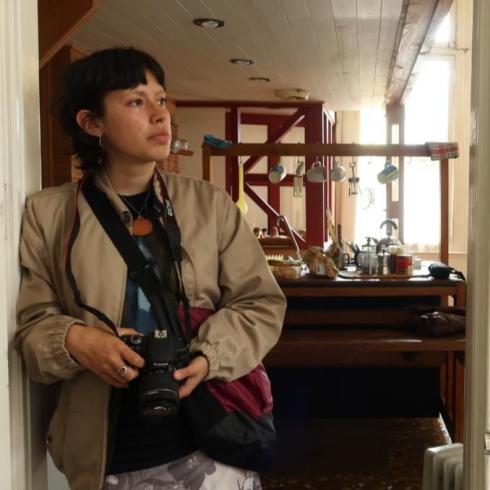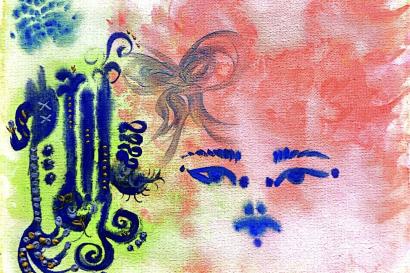Participating in a protest action along the Atocha train station area was one of the most remarkable moments of my time in Madrid. The march brought together activists championing a wide range of causes—from Palestine liberation to women’s rights—and culminated in a vibrant demonstration as we moved through the streets to the Gran Vía and Puerta del Sol. The atmosphere was electric, with drums and music echoing through the city, banners swaying overhead, and an infectious sense of unity among participants. Along the route, artists had set up makeshift print stations to create and distribute screen printed posters, transforming cardboard and paper into powerful statements of protest. Carrying one of these posters felt like holding a piece of history—a tangible reminder of the interconnectedness of struggles for justice and equality.
History of Spanish feminism
The feminist movement in Spain has a long and tumultuous history, marked by periods of intense activism, repression, and resurgence. Its roots can be traced back to the late 19th and early 20th centuries, when women began organizing for basic rights such as education, labor protections, and suffrage. During the Second Republic (1931-1939), feminism gained significant momentum, with activists like Clara Campoamor leading the charge for women’s right to vote, which was achieved in 1931.
However, the rise of Franco’s dictatorship in 1939 brought a dramatic halt to feminist progress. Under Franco’s regime, women were relegated to traditional roles as wives and mothers, stripped of many legal rights, and subjected to the strict moral codes of the Catholic Church. Feminist activism was forced underground, and it wasn’t until Franco’s death in 1975 that Spain saw a resurgence of feminist movements.
The democratic transition of the late 1970s was a turning point for feminism in Spain. Women began to reclaim their voices, advocating for legal reforms and cultural shifts to address gender inequality. The 1980s and 1990s saw significant achievements, including the legalization of divorce, increased access to contraception, and the establishment of laws aimed at protecting women from domestic violence.
Feminism in Madrid, today
Today, Madrid stands at the forefront of feminist activism in Spain, embodying a vibrant and diverse movement that addresses a wide range of issues. International Women’s Day on March 8th is particularly notable, drawing tens of thousands of people into the streets to march for gender equality, reproductive rights, and an end to gender-based violence. The city’s feminist groups are highly organized and intersectional, working to include the voices of marginalized communities such as immigrants, LGBTQ+ individuals, and women of color.
One of the most visible representations of modern feminism in Madrid is the city’s graffiti and street art. Walls throughout neighborhoods like Lavapiés and Malasaña are adorned with feminist slogans and imagery, turning public spaces into canvases for resistance and empowerment. Messages like “Nos queremos vivas” (“We want to stay alive”) and “El futuro es feminista” (“The future is feminist”) serve as daily reminders of the movement’s presence and urgency.
The city also hosts numerous feminist cultural events, from film festivals to academic conferences, that explore topics like gender representation in media, intersectionality, and the history of women’s rights in Spain. Organizations such as Mujeres en las Artes Visuales (Women in Visual Arts) and Fundación Mujeres (Women’s Foundation) play a crucial role in fostering these dialogues and supporting women in various fields.
Reflecting on this experience
What struck me most during the protest march was the seamless integration of feminist issues with other struggles for social justice. Women’s rights were not presented in isolation but as part of a broader tapestry of activism. Banners advocating for climate justice, workers’ rights, and LGBTQ+ equality moved side by side, illustrating the interconnectedness of these causes. This intersectionality is a hallmark of modern feminism in Madrid. Activists here recognize that gender inequality cannot be fully addressed without considering how it intersects with other forms of oppression. For instance, immigrant women face unique challenges, from navigating legal systems to confronting cultural biases, while LGBTQ+ women often contend with both sexism and homophobia. Madrid’s feminist movement strives to create spaces where these diverse experiences are acknowledged and amplified.
As I marched from Atocha to Gran Vía, surrounded by music, art, and solidarity, I felt an overwhelming sense of connection. This wasn’t just a protest; it was a celebration of collective resistance and hope. Holding the screen printed poster I had received along the way, I thought about the countless hands that had contributed to this moment—the activists organizing on the ground, the artists crafting powerful visuals, and the everyday people showing up to make their voices heard.

Layla Santiago
An avid hiker and rookie musician, I love being outdoors and jamming on the guitar whether solo or with friends. Having Mixtec, Mexican, and Polish heritage has allowed me to appreciate diverse cultures and perspectives.





